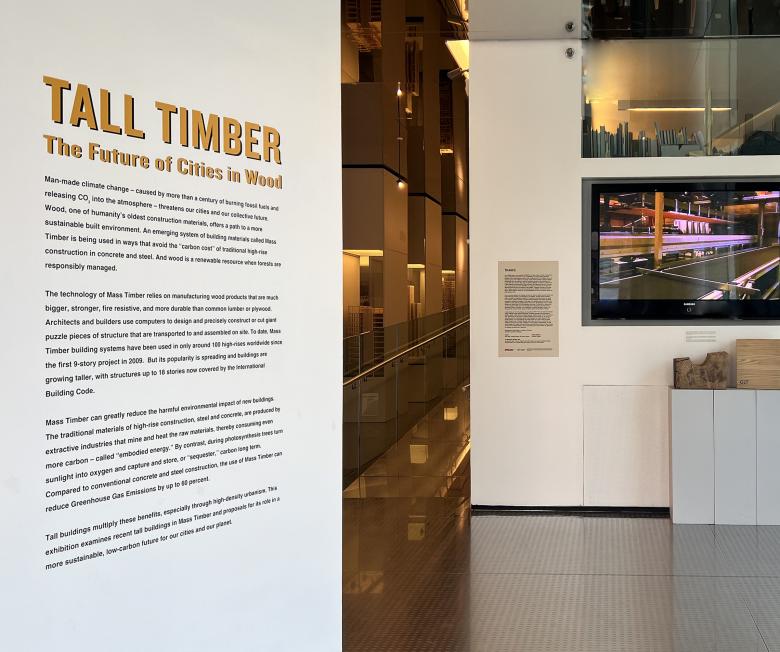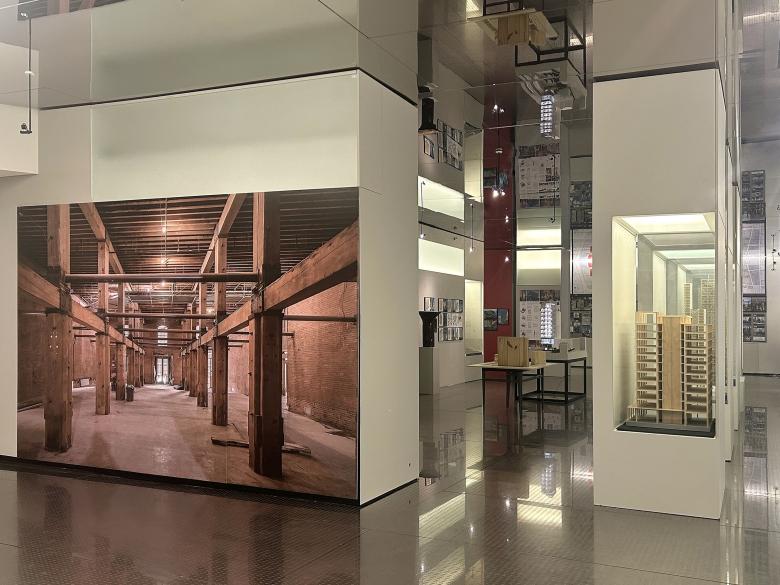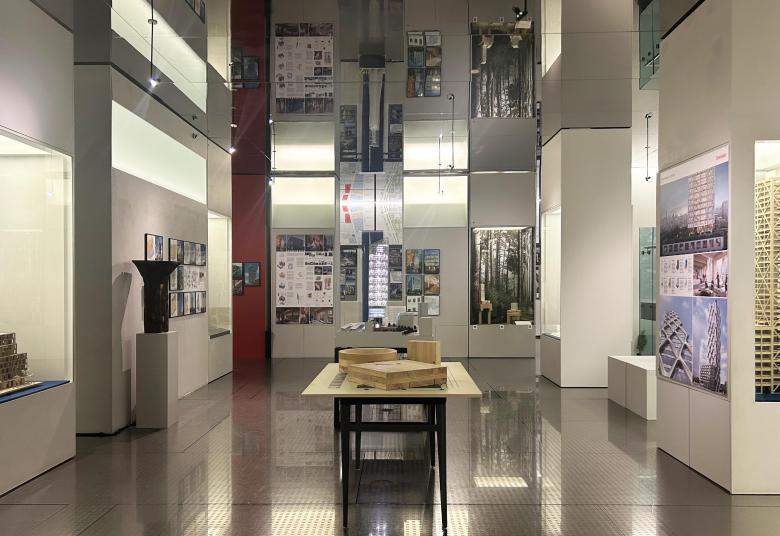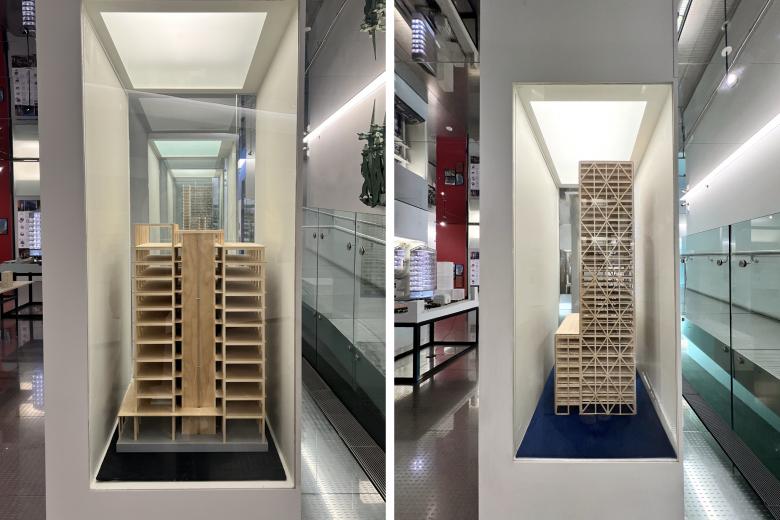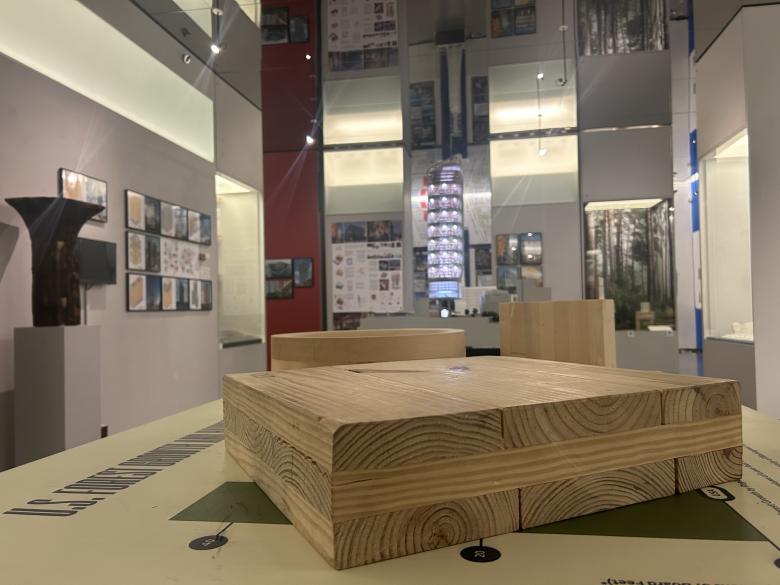15. March 2024
Photo courtesy of The Skyscraper Museum
Tall Timber: The Future of Cities in Wood opened at the Skyscraper Museum in Lower Manhattan in late February. World-Architects stopped by to see which projects are included in the exhibition, what they say about the current state of mass timber, and what they portend to the future of cities in wood.
Back in 2016, I was hired to write How to Build a Skyscraper, an illustrated collection of nearly four-dozen built skyscrapers spanning more than a hundred years. Although I was able to negotiate some changes to the list of skyscrapers the publisher gave me, I was not able to get a mass timber skyscraper among them, no matter how much I tried or wanted to include one. Mass timber buildings at the time were just too short, hardly skyscraper-like when seen next to the 21-story Flatiron Building, much less the 828-meter (2,717-foot) Burj Khalifa. Then, the tallest building with an all-timber structure was just 14 stories, while the tallest hybrid-timber building reached a height of 22 floors — but with a caveat: it was actually a 16-story structure atop an existing building.
Faced with this situation, I thought of mass timber buildings then as aspirational and likened them to the early skyscrapers in Chicago and New York in the 1880s: Short by today's standards, they pushed the boundaries of technology, engineering, and safety in their time, just as the increasing numbers of buildings around the world using CLT (cross-laminated timber), GLT (glue-laminated timber), LVL (laminated-veneer lumber), and other variations on engineered mass timber are pushing manufacturers, engineers, and regulators to find ways to build taller with wood. Who knows, by the end of our current century cities may be full of “tall timber”: skyscrapers structured predominantly in wood rather than steel or concrete.
Photo courtesy of The Skyscraper Museum
Fast forward just three years, to 2019, and the tallest mass timber building in the world — Mjøstårnet, an 18-story mixed-use tower in Brumunddal, Norway, designed by Voll Arkitekter AS — topped out at 85.4 meters (280 feet), about 50 feet (15m) taller than the tallest in 2016. Three years later, in 2022, the Ascent residential tower in Milwaukee, Wisconsin, designed by Korb + Associates Architects, bested the tower in Norway as tallest mass timber building — by just four feet (1.2m)! Given that the 2021 International Building Code limits mass timber buildings to just 18 floors (technically 21-story buildings are allowed, with 18 floors of timber framing above three floors of non-combustible framing) the next “tallest timber” won't be much taller than Mjøstårnet or Ascent. (That said, hybrid structures, such as SHoP Architects' 42-story Atlassian Headquarters underway in Sydney, with wood floors inside a steel exoskeleton, will be considerably taller.)
All of this begs questions: Are record-breaking building heights the best way to track progress on tall timber? Shouldn't the benefits of building in mass timber (sequestering carbon, using renewable resources sustainably, increasing user comfort, speeding up construction, etc.) outweigh the race to the tallest that seems to infatuate skyscraper aficionados? Shouldn't building more buildings out of mass timber be the goal, rather than building them taller? “Tall buildings multiply these benefits, especially through high-density urbanism,” is one answer, as written in the intro text of Tall Timber: The Future of Cities in Wood now at The Skyscraper Museum, the Lower Manhattan institution headed by historian Carol Willis. The small but timely and impactful exhibition “examines recent tall buildings in Mass Timber and proposals for its role in a more sustainable, low-carbon future for our cities and our planet.”
Photo courtesy of The Skyscraper Museum
Built upon Reframed: The Future of Cities in Wood, the 2023 exhibition at the Chicago Architecture Center, Tall Timber begins with charts and data from the earlier show that espouse the benefits of using wood rather than steel or concrete, but then, unlike Reframed, Willis focuses its attention on buildings ten stories and greater. The three towers in Brumunddal, Milwaukee, and Sydney mentioned above are in the show, accompanied by numerous other tall buildings in wood designed by LEVER Architecture, Michael Green Architecture, atelierjones, 3XN, KPF, SOM, Perkins&Will, Gensler, LSW Architects, and other firms around the world. Not all of the case studies in the exhibition were built. Most notably, the two winners of the U.S. Tall Wood Building Prize Competition, organized in 2014/15 by the United States Department of Agriculture (USDA) and the Softwood Lumber Board — Framework, a 12-story mixed-use building designed by LEVER, and 475 West 18th, a ten-story residential building designed by SHoP — were not realized, regardless of the funding and attention received through the competition.
Framework is one of three scale models in the museum's vitrines (left in below photo). The other two are Perkins&Will's River Beech Tower, a research project for an 80-story tower that would be made with CLT floors, an LVL diagrid, and GLT walls and cross-bracing, and Proto-Model X (PMX), a 35-story mixed-use tower that Gensler designed for Sidewalk Labs' aborted Quayside Toronto development (right in below photo). Gensler released its design for the cross-braced timber tower in January 2020, two months before the Covid quarantine and four months before Sidewalk Labs abandoned the Quayside project; in fact, most of the projects in Tall Timber, including all of the ones mentioned above, date to before the pandemic. A tall timber audit by the CTBUH (Council on Tall Buildings and Urban Habitat) sensibly shows a steep drop in the number of mass timber buildings eight stories or more in 2020, but more telling is how completions in the years since, although they have rebounded, are still far short of pre-pandemic levels, particularly 2017–19. Of course, the number of tall buildings in wood is small compared to those framed in steel and/or concrete.
Photo courtesy of The Skyscraper Museum
Many of the visitors to The Skyscraper Museum in Lower Manhattan are not architects, so particularly helpful to them are 1:1 pieces of timber that are positioned throughout the small gallery. They start with a section of heavy timber that was salvaged in COOKFOX's adaptive reuse of the Terminal Warehouse in Chelsea (the project is also shown large in the exhibition, as seen in the second photo above); next to this piece of a column made from a large pine tree is a comparably sized cube of GLT, a piece of engineered lumber whose production is explained in a video from a production factory above them. So visitors see immediately how contemporary timber architecture is industrial, with smaller pieces of lumber laminated into larger structural members, more pieces of which are presented on a table in the middle of the gallery (photo below).
But visitors still may be questioning the applicability of wood to tall buildings. Don't architects remember the Great Chicago Fire, which prohibited wood buildings after the flames subsided in 1871? Their concerns should be tempered (no pun intended) by the display of a charred column from Ascent, the current tallest timber tower, next to a video documenting the three-hour fire resistance test it went through. While it may seem counterintuitive, mass timber structures actually meet, and often exceed, code-mandated fire resistance requirements, aided by the char layer that forms — and which visitors can smell on the column.
Photo courtesy of The Skyscraper Museum
Does the slow rebound of tall buildings in mass timber in the years since the pandemic portend “cities of wood” in the future? Exhibitions like Reframed and Tall Timber (hopefully they are just two of many more on the subject) should hopefully entice architects, clients, and the general public to demand more buildings in mass timber, tall and otherwise. The benefits are clearly on display and spelled out in words in the gallery and online, but widespread progress on building in mass timber is frustratingly slow, especially for people who believe that our climate emergency requires swift attention and the shift from extractive, carbon-heavy materials like steel and concrete to renewable, carbon-neutral materials like wood should be an important part of that. There are bright spots, such as local jurisdictions allowing mass timber construction up to certain heights and therefore not requiring costly and lengthy tests and variances, but if tall buildings are multipliers of mass timber's benefits, as Willis and Tall Timber assert, those height limits need to be lifted higher — and sooner rather than later.
